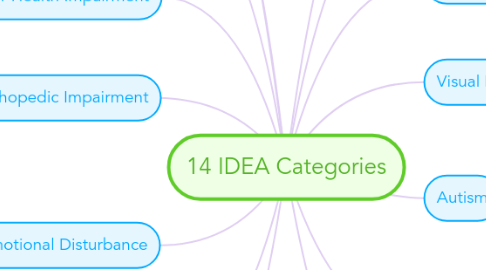14 IDEA Categories
作者:Erin Healy

1. Developmental Delay
1.1. A delay in physical, cognitive, social, or emotional development. Usually this presents early in a students' development. Between the ages of 3 and 9.
2. Emotional Disturbance
2.1. An inability to learn that cannot be explained by intellectual, sensory or health factors. Inability to establish relationships with teachers or peers. Fears, unhappiness, depression that adversely affect the student's education.
2.1.1. Based on Megan's case study she suffered from depression and emotional problems. Her cognitive and developmental achievement scores were high but her stress, anxiety and depression levels were high and she may need intense intervention in the future.
3. Orthopedic Impairment
3.1. Severe orthopedic impairment usually related to a disease such as bone tuberculosis or cerebral palsy. These impairments cause adverse affects in a student's education.
4. Other Health Impairment
4.1. Any health conditions that may impede on the education of the student. Conditions that limit a student's strength or alertness or responses to stimuli
5. Specific Learning Disability
5.1. Any condition that impedes with the ability to write, speak, read, or perform mathematical equations. These conditions include perceptual disabilities and conditions like dyslexia.
5.1.1. Nick presented with low math scores and when he was tested in Language his marks were at grade level. Nick was diagnosed with a mathematical reasoning disorder.
6. Speech or Language Impairment
6.1. Stuttering, language impairment or hearing articulation are examples of conditions of speech or language impairment. Special education services are available to help with these impairments.
7. Traumatic Brain Injury
7.1. Damage to the brain caused by external force. As a result of the injury the student suffers from partial functional disability or psychosocial impairment.
8. Source
8.1. www.parentcenterhub.org
9. Autism
9.1. A developmental disability which affects verbal and nonverbal communication as well as social interactions. Autistic students rely on structure and routines. Learning is heavily repetition based.
10. Deaf/Blindness
10.1. A combination of hearing and vision impairments that creates severe communication, educational and developmental needs that cannot be accommodated by special education alone.
11. Deafness
11.1. A severe hearing impairment. Linguistic development is delayed due to the impairment. Amplification can be used as a tool to help in the student's education however this condition adversely affects the students learning abilities.
12. Hearing Impairment
12.1. Hearing is impaired but the student is not deaf. Amplification maybe used to help in a special education or general classroom setting.
13. Intellectual Disability
13.1. Subaverage general intellectual learning ability combined with deficits in social and cognitive growth.
14. Multiple Disabilities
14.1. Multiple disabilities occurring at the same time. These disabilities inhibit the student's ability to function with in the special education program.
15. Visual Impairment
15.1. inhibits a student's vision and thus affects their educational learning. This includes blindness. Even with correction students may not have fully functioning vision


